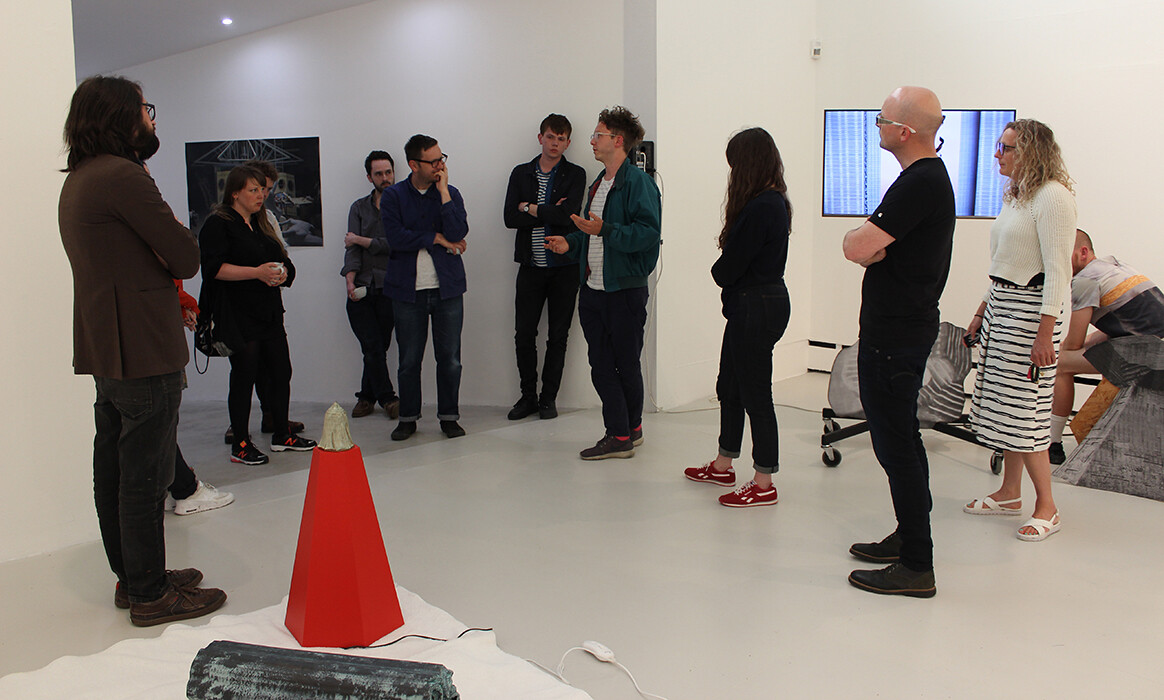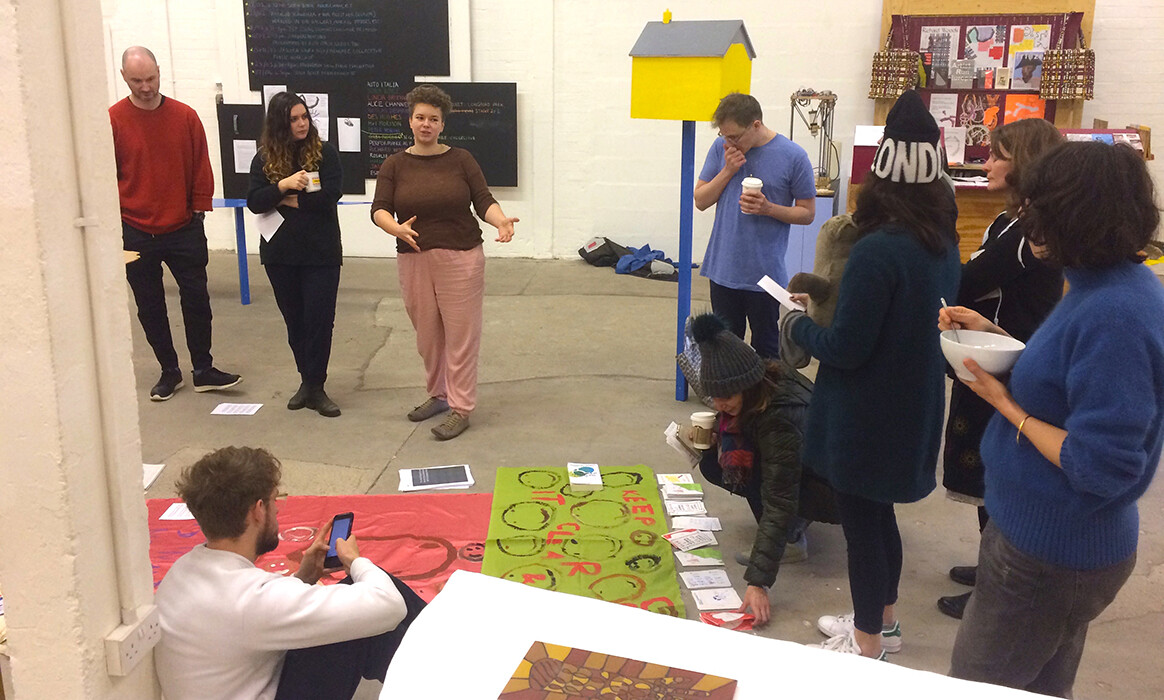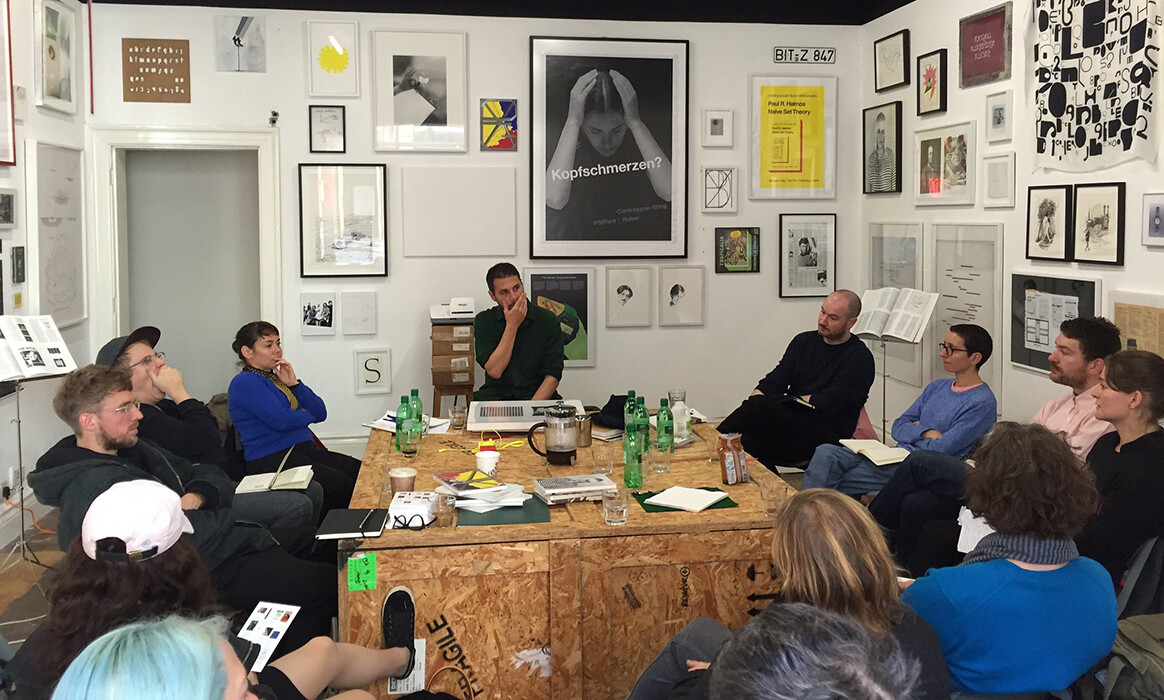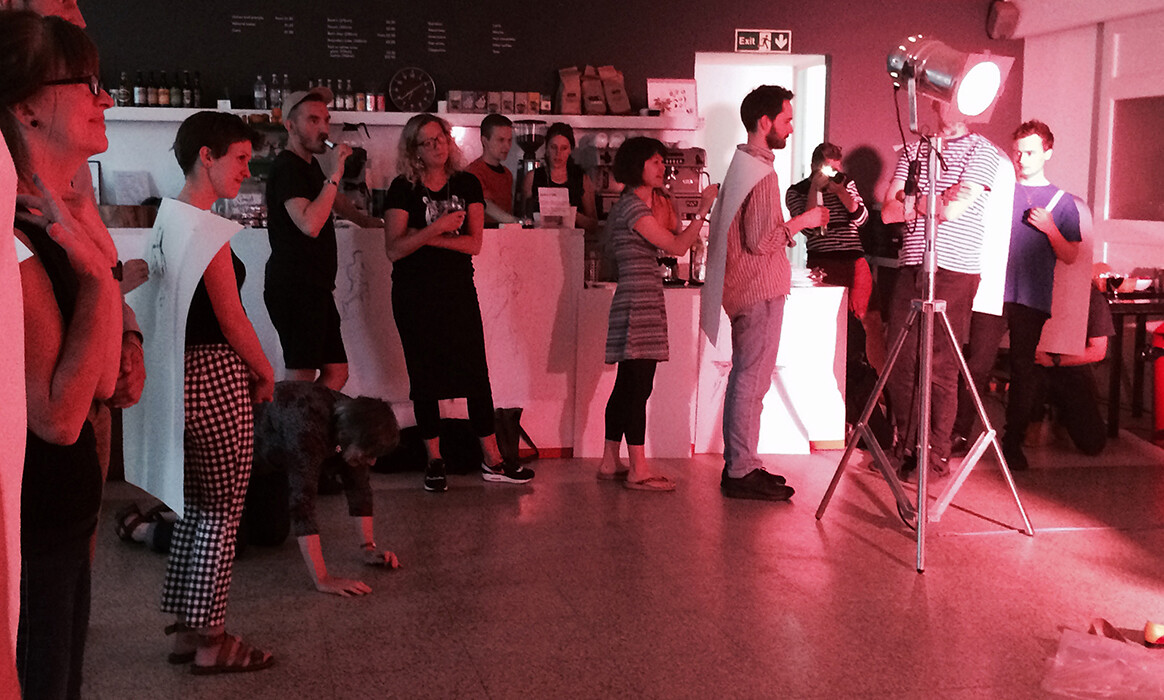“Networks” and “conversations” are two of the most frequently used words by those describing the Syllabus, a ten-month alternative art education program run by a partnership of six England-wide nonprofit visual arts organizations. Whether it’s the ten artist participants wishing to connect with peers, or the organizations wanting to develop closer and more meaningful relationships with each other and the artists they support, there is a shared desire for real and tangible connections.
While artists are more connected than ever thanks to the ubiquity of social media, it’s still real-world, in-person social interaction that allows for the depth and breadth of discussion many artists crave, and the supportive yet challenging environment of art school remains difficult to replicate on the internet. Developing one’s art practice in a community that encourages by way of critique is, of course, why many artists embark on a master’s degree—an opportunity to reappraise their work through the constructive criticism of lecturers and fellow students. Crucially, though, the Syllabus is peer led. There are no “students” or “lecturers” as such, because Syllabus isn’t “art education” in any traditional sense.
“It’s not teaching,” stresses Ruth Claxton, associate director of Eastside Projects, an artist-run space in Birmingham and one of six partners involved in Syllabus II. (The others are: Wysing Arts Centre, Cambridge; S1 Artspace, Sheffield; Spike Island, Bristol; Studio Voltaire, London; and New Contemporaries, London.) “For me, it’s a ‘working things out together’ sort of scenario, so in that sense everyone is learning. It’s not like it’s the organizations and then the artists, it’s much more discursive than that. I think of it as a series of critical conversations that everyone benefits from.”
For the current session, those conversations began September 2016 during a weekend retreat at a former farmhouse on the Wysing Arts Centre’s campus; the full program sees all the partner organizations host retreats at roughly two-month intervals, culminating in a return to Wysing in late June. Between each retreat, the artists are assigned readings and maintain discussions from one retreat to the next, sharing suggestions for future weekends. This self-initiating, conversational approach was instilled from the beginning of Syllabus II. In keeping with the program’s strong peer-led ethos, a key aspect of the initial gathering at Wysing was a lively discussion about what the curriculum should comprise. Following a presentation by each artist of their work, a session led by curator George Vasey—one of two mentors on this year’s program, the other being artist Milly Thompson—produced a long list of questions for consideration over the course of Syllabus II. Along with input from the partners, these included: “How do we escape politeness?,” “How do we make politics present in the work without being didactic?,” and, perhaps most urgently in the era of Brexit and Trump, “How do we make art when we are all fucked?”
These and other questions were the starting point for the February retreat at Eastside Projects, the fourth in the current program. “We chose that set of questions from the bigger list because they felt very appropriate for an artist-led space to tackle,” explains Claxton. The three days at Eastside Projects featured a series of individual, conversation-based critiques, an aspect of all retreats, and discussions with guest contributors, including curator Teresa Cisneros and artists Celine Condorelli and Rosalie Schweiker, addressing subjects such as collaboration, friendship and solidarity, and the “joy of admin.” At one point, Schweiker had the group sing a “new national anthem,” replacing the lyrics of “God Save The Queen” with lines about the challenges of being a practicing artist. Prior to the weekend, all the Syllabus artists were invited by Eastside Projects to produce a short sound piece that would be broadcast to the gallery’s street.
As the Eastside retreat suggests, the Syllabus curriculum and its intention of fostering critical engagement with artists’ practices are very much rooted in what it means to be an artist now. The program has been designed to evolve and adapt with each iteration. Responding to both the needs and desires of the artists and wider social, economic, and political contexts, there is an eagerness to avoid the institutional rigidness that can characterize more formal postgraduate education. This foundation in everyday artistic practice can in part be explained by the genesis of the Syllabus idea. The seed was planted a few years prior to its 2015 launch as it became clear that, while individually each organization could provide critical and professional development for artists through their various “associates” schemes, collectively they could do so much more.
“The very early conversations were around how we could bring more to the artists who were already closely associated with our programs,” says Donna Lynas, director of Wysing, the lead organization for the Syllabus. Asked whether the Syllabus was conceived with any existing model in mind, Lynas responds: “Nothing direct, although there’s always the nostalgia of Black Mountain College in the back of everyone’s mind. That is probably the biggest reference of all, even though it has quite a mythical status.” Closer to home, she cites London-based School of the Damned, a free, artist-led postgraduate art course “run by, and for, its students.” “It was seeing how they organize things, it’s a very democratic approach,” she explains. “Ultimately, the more you can input into something, the greater you feel invested in it, and I think that was the key example given by School of the Damned.”
The impetus to create the program was also a response to developments in the UK’s educational climate wherein tuition charges increased and course options narrowed. “I was becoming acutely aware of the changes taking place in higher education,” says Lynas. “There was a lot of discussion around how artists were struggling to go to college and that some of them didn’t necessarily want to—there weren’t the courses they were happy with—and the question of cost kept coming up. And so, at some point it became about how we could offer something to people who haven’t really got the finances to go and do an MA.”
Cost-wise, the difference between the Syllabus and an institutional master’s program is stark: nominally, the tuition for Syllabus is £3000, but thanks to Wysing Art Centre’s Arts Council England funding, Syllabus participants pay only £500, plus some costs for travel and accommodation estimated at an additional £500. By comparison, a two-year MFA at a high-profile art college in England such as Goldsmiths, University of London costs over £9,000 for the 2017–18 academic year for UK or EU students; international students pay over £21,000.
Early conversations among the partner institutions about what would become the Syllabus often grappled with the idea of “offering something that perhaps an established MA couldn’t.” The question of whether the Syllabus is a challenge to formal postgraduate education remains a point of contention. For the current Syllabus cohort, however, it would appear to be a debate that has already run its course, as artist Faye Claridge explains: “Every now and then people talk about it [in those terms] and we all pull a bit of a face. Not that there’s anything wrong with doing an MA, far from it—I got a lot from doing one. But this is very, very different.”
The differences, says Claridge, start with the selection process and continue through the program. “The fact that there’s only ten of us and that we were all chosen simultaneously by experienced people who were comparing us and imagining how we’d work together in a group has made a huge difference. We feel like we’re almost a curated group already—or at least I do—there are so many interesting differences and connections and the level of commitment from everyone is extraordinary. You have to be committed to do an MA, but even more so here.” This “curated group” includes artists with a diverse array of practices that encompass painting, sculpture, installation, and performance, with multidisciplinary and curatorial practices also included. “There’s a shared experience level among the artists, and because it was made clear that it was going to be very much directed by the artists this time, it attracted people who had that kind of drive and really wanted to take responsibility and make things happen.”
Syllabus II’s emphasis on peer-led learning represents the evolving nature of the program and a shift from the first year which, while still avoiding a prescribed student-teacher dynamic, operated from a pre-planned curriculum. Simon Bayliss, a Cornwall-based artist, was part of that first Syllabus cohort, and ten months after completing the program he says the participants still meet regularly. He is collaborating with fellow Syllabus artist Susie Green, and was encouraged to start a new project, the Artist Tea Towel Company, after receiving a positive response for the idea. Bayliss completed an MFA at Burren College of Art, Galway in 2011, and in contrast to his experience in Ireland he describes Syllabus as being “much more like professional development” than an MA. In a similar vein, Bayliss is unequivocal when asked if it matters that the Syllabus demands a significant commitment in time and intellectual engagement yet offers no formal qualification: “It doesn’t matter in the slightest. In terms of my CV, I can say that I was supported by the Syllabus, produced in conjunction with six of the top art institutions in the UK. That’s quite an impressive thing.”
Bayliss’s high opinion of the organizations behind the Syllabus—which for Syllabus III have grown to seven with the addition of a new partner, London’s Iniva—is shared by Syllabus II participant Mira Calix, a sound artist signed to Warp Records. “It was seeing that this particular group [of organizations] had come together to do this thing that made me want to apply,” says Calix, who did her undergraduate course in digital media and photography in her home country, South Africa, and hasn’t done an MA. “I didn’t think about getting a qualification.”
That a sound artist and musician like Calix is a Syllabus participant is indicative of the non-prescriptive approach of the program. In fact, the only criteria for applicants is that they have been “out of formal education for approximately four years”; the call for Syllabus III also welcomes applications from artists “who have not progressed through formal art training routes.” Whether intentionally or not, the Syllabus offers a benign challenge to the presumption that to be an artist one must have studied at an art school. With the support of a network of respected visual arts organizations that commissions and exhibits the work of artists on a regular basis, it provides a robust and credible program. And, as Lynas concedes, thanks to its Arts Council England funding, it can operate without the financial and institutional pressures that increasingly influence the university sector. As she puts it: “What all the partners are interested in is artists and practice—that’s why we’re doing this.”
—Chris Sharratt






